This biographic document recounts the odyssey of a mop and a stalker who was accused in the UGT mason and became revolutionary and man of action of the CNT. It is the life of the mason who commanded the Fourth Army in the Civil War and defeated Mussolini's generals at the Battle of Guadalajara. Losing the war earned him 3 years of concentration camps and prisons in the French territories in North Africa, and was finally delivered to the Spanish authorities, who condemned him to death. After saved from condemnation, Mera was exiled to France, where he never stopped fighting to end Franco.
Figueres Valenti tells the exegesis of the film-paper on the figure of the great fighter Republican:
"The feature film project starts when we meet in Paris Imbernón Nardo and teaches us a silver fork that had been jealously guarded since his father gave him. The holder had an interesting story: when the Aga Khan III and Rita Hayworth iban with his limousine by the Bois de Boulogne were assaulted by several cars that they blocked the way. The assailants left them with nothing, no costumes, jewelery and cutlery. That robbery worthy of being in a film script, was actually "a recovery "and the masked men from the" Action groups of the CNT. "It was 1949. Later the fork came into the hands of the family of Nardo, long anarchist tradition, jokingly boasted that eat like the rich with that covered".
The story aroused our curiosity, who were these "appropriators"? Was Robin Hood or simple modern assailants of roads?
Nardo was shelling us the story of "the men of the CNT", the how, the why, the facts and anecdotes of those who lost the Civil War and were victims of all totalitarian regimes, those who lived through the eternal hope of the return to Spain, but also the struggle and the death of his "peers." Appeared before our eyes underground world and almost extinct exile kept fresh in memory, despite the time... and time.
We were discovering the world of old anarchists, the fighters of "La Idea", the "affinity groups". They were men and women who had an ideal to strive for and did so with its own language. "The Idea," as known in the anarchist movement to the concept of social justice and freedom, had entered his life and never to leave him.
The libertarian tradition stretches back in time to the S. XIX and XXI have continued to. It is true that their survival is irregular and ends truly critical. But there was a window of time and space in the twentieth century, in which everything could be, a crack in the anarchist ideas that might have a chance: The year was 1936 and the place, Spain. Some called it "The Spanish Civil War, "anarchists "The Spanish Revolution."
Of all those "men of the CNT", of all partners, especially captivated us the story of Cipriano Mera. With more than humble origin in the Madrid district of Tetuan,-then called "the victories" - Mera was a mason, a trade unionist, a Fellow of the CNT and when the time required it, a lieutenant colonel of great instinct. After the defeat and exile, but his job as a bricklayer, but committed militancy from the "outside" and an obsession to kill the dictator. Mera was a partner as a militant few to none. He joined without hesitation in the groups of youths libertarian to devise plans for the assassination and took to the barricades in the streets in May '68. Never stopped believing in the viability of libertarian ideas that were inevitable as a matter of common sense. The irony of history willed that died 20 days before Franco. Cipriano did not win every war, but fought in every battle.
That was Cipriano Mera and that was the mysterious world of the old anarchist. A world where the need for a "partner" was a thing of all. They had been so close to the revolution, to believe it was a matter of seeing and acting accordingly. For older anarchists did not make sense to choose between dying standing or live on your knees, they knew that another world is possible, you could have the whole. The choice, of course, was "living pie".
A unique document in a pleasant way to see another version of the history of Spain, which peaked "the other half" of its population struggling to keep the Republican government, legally recognized in the polls, but after losing the war, was silenced for over forty years.
Vivir de pie: Las guerras de Cipriano Mera (2009)
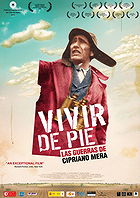 Posted : 13 years, 2 months ago on 25 February 2012 12:49
(A review of Vivir de pie. Las guerras de Cipriano Mera)
Posted : 13 years, 2 months ago on 25 February 2012 12:49
(A review of Vivir de pie. Las guerras de Cipriano Mera) 0 comments, Reply to this entry
0 comments, Reply to this entry
The Skeleton of Mrs. Morales (1960)
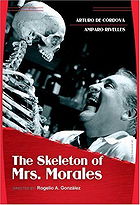 Posted : 13 years, 2 months ago on 24 February 2012 10:35
(A review of Skeleton of Mrs. Morales)
Posted : 13 years, 2 months ago on 24 February 2012 10:35
(A review of Skeleton of Mrs. Morales)Ranked as one of 100 great films classic of Mexican cinema, and prominent, 19. After hearing, also i think it is so be it full justice.
Considered as the only black comedy film produced in Mexico, adapting a story by gothic writer Arthur Machen. Luis Alcoriza -Buñuel regular contributor- is responsible for the script, and it shows its corrosive hand throughout the filming. The photograph, in black and white almost essential, it is also outstanding, with excellent use of chiaroscuro and the camera angles, sometimes implausibles. Add to that an outstanding performance of its main actors, Arturo de Córdova and Amparo Rivelles, and its cast of secondary effective, the recipe has all the ingredients for a most delicious dish.
In the background of "The Skeleton of Mrs. Morales" there is a brave and determined social criticism, especially towards to the field and those who support church, something unusual in a country so prone to religious manifestations. Although a close look an addition, as compensation to the sanctimonious, not detract from the overall tone of the film in terms of comedy. To spend a most enjoyable time.
Considered as the only black comedy film produced in Mexico, adapting a story by gothic writer Arthur Machen. Luis Alcoriza -Buñuel regular contributor- is responsible for the script, and it shows its corrosive hand throughout the filming. The photograph, in black and white almost essential, it is also outstanding, with excellent use of chiaroscuro and the camera angles, sometimes implausibles. Add to that an outstanding performance of its main actors, Arturo de Córdova and Amparo Rivelles, and its cast of secondary effective, the recipe has all the ingredients for a most delicious dish.
In the background of "The Skeleton of Mrs. Morales" there is a brave and determined social criticism, especially towards to the field and those who support church, something unusual in a country so prone to religious manifestations. Although a close look an addition, as compensation to the sanctimonious, not detract from the overall tone of the film in terms of comedy. To spend a most enjoyable time.
 0 comments, Reply to this entry
0 comments, Reply to this entry
Count Dracula (El conde Drácula, 1970)
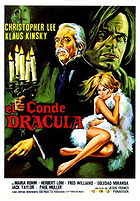 Posted : 13 years, 2 months ago on 23 February 2012 10:37
(A review of Count Dracula )
Posted : 13 years, 2 months ago on 23 February 2012 10:37
(A review of Count Dracula )Even though "Count Dracula" is another of the usual B-movies in the cinema of Jesus Franco, is possibly the most budgets. His approach was based on industrial leverage international successes of Hammer Films productions with Christopher Lee in the famous role of vampire Count.
Despite this, the film is a more accurate recreation of Stoker's novel that he had played any of the above English productions. And perhaps here is the main problem of the film. The strong personality of the filmmaker and his delirious baroque aesthetic and collide with the original Victorian text, more rigorous and subtle. Franco himself admitted the matter: "I defend even acknowledge that you have to attack it (the movie)."
The movie goes more to less, with jumps and a vague aesthetic argument that the unbalance and undermine the credibility of the action, especially towards the end. On the positive side, the attention to the literary original since it is the first film about Dracula in which the vampire progressively rejuvenated by the blood of their victims. Also some other scene that should be rewarded, as the short sequence, both sweet and macabre, set in a dark park and in which Lucy Westenra (Soledad Miranda), and vampirized, captures the attention of his victim in the figure of a little girl separated from her playmates.
By the way, excellent Spanish actress in her first performance in a film by Franco. Not its main character, Christopher Lee, who seems lethargic or unmotivated in the same paper, several times repeated, which had enthroned ten years before in the world of cinema. With respect to Klaus Kinski, playing his first appearance since a Renfield mad and say that his character is at the same time, so moving and disturbing. His performance, as "balanced" as intense. His characterization is the largest decline due to complete a excessive grooming in immaculate white dress and her hair always freshly washed. Herbert Lom comprises an effective Van Helsing, though perhaps too sober. In their defense and according to the actor himself, had to make the replicas imagining the presence of Lee, all based on reverse shots, having already left the set that actor.
The musical section of lower pitch and less prominence than usual. Count Dracula is presented with harp arpeggios while other sequences show musical avant-garde abstractions, all in line with its eclectic director.
At this time, early seventies, Jesus Franco film begins to be cause for criticism in his homeland for his propensity for pornographic genre. While critics and the profession you are losing respect in Spain, across Europe work is becoming better known and well recognized.
Despite this, the film is a more accurate recreation of Stoker's novel that he had played any of the above English productions. And perhaps here is the main problem of the film. The strong personality of the filmmaker and his delirious baroque aesthetic and collide with the original Victorian text, more rigorous and subtle. Franco himself admitted the matter: "I defend even acknowledge that you have to attack it (the movie)."
The movie goes more to less, with jumps and a vague aesthetic argument that the unbalance and undermine the credibility of the action, especially towards the end. On the positive side, the attention to the literary original since it is the first film about Dracula in which the vampire progressively rejuvenated by the blood of their victims. Also some other scene that should be rewarded, as the short sequence, both sweet and macabre, set in a dark park and in which Lucy Westenra (Soledad Miranda), and vampirized, captures the attention of his victim in the figure of a little girl separated from her playmates.
By the way, excellent Spanish actress in her first performance in a film by Franco. Not its main character, Christopher Lee, who seems lethargic or unmotivated in the same paper, several times repeated, which had enthroned ten years before in the world of cinema. With respect to Klaus Kinski, playing his first appearance since a Renfield mad and say that his character is at the same time, so moving and disturbing. His performance, as "balanced" as intense. His characterization is the largest decline due to complete a excessive grooming in immaculate white dress and her hair always freshly washed. Herbert Lom comprises an effective Van Helsing, though perhaps too sober. In their defense and according to the actor himself, had to make the replicas imagining the presence of Lee, all based on reverse shots, having already left the set that actor.
The musical section of lower pitch and less prominence than usual. Count Dracula is presented with harp arpeggios while other sequences show musical avant-garde abstractions, all in line with its eclectic director.
At this time, early seventies, Jesus Franco film begins to be cause for criticism in his homeland for his propensity for pornographic genre. While critics and the profession you are losing respect in Spain, across Europe work is becoming better known and well recognized.
 0 comments, Reply to this entry
0 comments, Reply to this entry
She Killed in Ecstasy (1971)
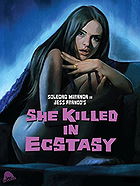 Posted : 13 years, 2 months ago on 22 February 2012 10:44
(A review of She Killed in Ecstasy)
Posted : 13 years, 2 months ago on 22 February 2012 10:44
(A review of She Killed in Ecstasy)Filmed almost simultaneously with "Vampyros lesbos" - commonplace in the career of its author that the parallel shooting different films - "She Killed in Ecstasy" is one of the best examples of the peculiar work of Jesus Franco.
The Spanish director has always been an esthete and a voyeur at any cost and the film not only contains Soledad Miranda in all its glory, is also a classic tale of revenge in which each frame, usually from odd angles, if not forced, it seems a cartoon illustration, typical film series B. The variegated colors of the interior decorative elements beyond the Pop Art and the presence of modern architecture on the outside are another element to consider. It also repeats the eclectic music of the german Hübler/Schwab combining Funk Jazz with natural sounds, distorted voices and presence of the sitar, composing a sounds very of its time, early seventies.
It is unfortunate that both your routine as your poor exposure and predictable plot development does not contribute to magnify a movie that just looks like a draft of her twin in gestation, the already mentioned "Las vampiras / Vampyros lesbos."
The Spanish director has always been an esthete and a voyeur at any cost and the film not only contains Soledad Miranda in all its glory, is also a classic tale of revenge in which each frame, usually from odd angles, if not forced, it seems a cartoon illustration, typical film series B. The variegated colors of the interior decorative elements beyond the Pop Art and the presence of modern architecture on the outside are another element to consider. It also repeats the eclectic music of the german Hübler/Schwab combining Funk Jazz with natural sounds, distorted voices and presence of the sitar, composing a sounds very of its time, early seventies.
It is unfortunate that both your routine as your poor exposure and predictable plot development does not contribute to magnify a movie that just looks like a draft of her twin in gestation, the already mentioned "Las vampiras / Vampyros lesbos."
 0 comments, Reply to this entry
0 comments, Reply to this entry
Gaslight (1944)
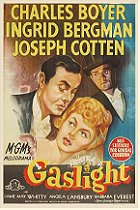 Posted : 13 years, 2 months ago on 21 February 2012 10:04
(A review of Gaslight)
Posted : 13 years, 2 months ago on 21 February 2012 10:04
(A review of Gaslight)Cukor never been a director that interests me too. His work seems formally correct but common or garden, without any originality, devoid of life. Do we owe, at least, being a great director of female stars, as has been said over and over again? It is possible, but... how often that he never worked bad actress?. Movie studios surrounded the good old Cukor always the most select group of actors, in the heyday of the Star system.
"Gaslight" is no exception to this. Actors first row as Ingrid Bergman (very young, but always perfect), a Charles Boyer as usual overacting, Joseph Cotten...
As for the story it tells, it is clear that the staging betrays its theatrical base. Almost all of the filming takes place indoors. Although he received an Oscar for best decorated and eventually could be prodigious, today leaves much to be desired, its obvious artificiality in the outlook and painted sections. This technical detail is to synthesize as can be said of its plot development: well presented, nice, but lacking in credibility. Since the beginning of the film's caution, the far-fetched, even absurd intentions of the male, which collapses all attempts to create an atmosphere of suspense. The "office" of Cukor knows maintain, despite all the interest in that account, the narrative follows a course and remains fluid, although abortive thriller to the end.
In my view, "Gaslight" belongs to a series of movies too many academics that have aged very bad and his previous but deserve recognition deciduous a further review.
"Gaslight" is no exception to this. Actors first row as Ingrid Bergman (very young, but always perfect), a Charles Boyer as usual overacting, Joseph Cotten...
As for the story it tells, it is clear that the staging betrays its theatrical base. Almost all of the filming takes place indoors. Although he received an Oscar for best decorated and eventually could be prodigious, today leaves much to be desired, its obvious artificiality in the outlook and painted sections. This technical detail is to synthesize as can be said of its plot development: well presented, nice, but lacking in credibility. Since the beginning of the film's caution, the far-fetched, even absurd intentions of the male, which collapses all attempts to create an atmosphere of suspense. The "office" of Cukor knows maintain, despite all the interest in that account, the narrative follows a course and remains fluid, although abortive thriller to the end.
In my view, "Gaslight" belongs to a series of movies too many academics that have aged very bad and his previous but deserve recognition deciduous a further review.
 0 comments, Reply to this entry
0 comments, Reply to this entry
Tampopo (Dandelion) (1985)
 Posted : 13 years, 2 months ago on 20 February 2012 06:16
(A review of Tampopo)
Posted : 13 years, 2 months ago on 20 February 2012 06:16
(A review of Tampopo)"Tampopo" was a popular film production in his country, Japan, but it has also been criticized for excessive wrapping western, like the West. After seeing this isn't the feeling I have left the movie. But for his pace, lighter than usual, I think a movie perfectly identifiable with japanese culture, starting because all argues for the country kitchen of the rising sun and the development of one of their dishes, noodles (ramen).
In the movie there is a main plot sprinkled with subplots, small and all of them interesting short stories, that revolve around the art of good eating. At no time "Tampopo" vision becomes cumbersome or boring, always refreshing, at times challenging and always enjoyable, fun.
Another curious feature to consider is the personality of its main interpreter, wearing a cowboy hat, and the first sequence where, certainly, its atmosphere and the individuals that people make us feel closer to a typical "saloon" of Far West that of a typical family japanese restaurant. This aesthetic is repeated at the end of the film with the (gunman) Goro away on his horse/truck on the horizon and composing a genre classic western.
In the movie there is a main plot sprinkled with subplots, small and all of them interesting short stories, that revolve around the art of good eating. At no time "Tampopo" vision becomes cumbersome or boring, always refreshing, at times challenging and always enjoyable, fun.
Another curious feature to consider is the personality of its main interpreter, wearing a cowboy hat, and the first sequence where, certainly, its atmosphere and the individuals that people make us feel closer to a typical "saloon" of Far West that of a typical family japanese restaurant. This aesthetic is repeated at the end of the film with the (gunman) Goro away on his horse/truck on the horizon and composing a genre classic western.
 0 comments, Reply to this entry
0 comments, Reply to this entry
Attack of the Robots (Cartes sur table, 1966)
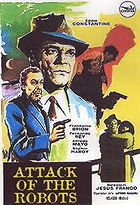 Posted : 13 years, 2 months ago on 19 February 2012 05:04
(A review of Attack of the Robots)
Posted : 13 years, 2 months ago on 19 February 2012 05:04
(A review of Attack of the Robots)"Cartes sur table" is a coproduction between France and Spain (in this later country was entitled "Cartas boca arriba") and opens a new stage in the filmography of Jesús Franco while the previous close. The one, because it rules out the terror, more or less gothic, in favor of new records. The other, because it is the filmmaker's latest movie in black and white, a change that would, paradoxically, for the worse.
Similarly, part of a shift occurring ironic that was years in some french films, the thrillers starring by Eddie Constantine. Franco also made with this actor an antihero -in the line marked by Lemmy Caution (Godard, 1965)- and his whole film seems imbued with the flavor of the Nouvelle Vague as the main source of inspiration: plot, aesthetics, tone, actors (the aforementioned Constantine, Françoise Brion, Sophie Hardy ...). There is even a mention of the french title as a direct homage to Godard's movie.
But this lighthearted but very well constructed story, mixing espionage with science fiction, also has parallels with the best French film avant-garde of that time to count as qualified co-wrote with Jean-Claude Carrière and music to the great Paul Misraki, that had just composed the soundtrack of Godard's "Alphaville" to name just two examples. Interpretive role is also to assess the work of veteran Spanish actors Fernando Rey and Alfredo Mayo.
Another interesting aspect is the settling of the film determined by the aesthetics of the comic narrative and theme, from now on, will reveal not only feature, but almost obsessive in the path of Franco: the appropriation of wills, the minds of both domination and bodies. In this respect I would add that, while watching the movie, I was reminded several times "Nuits rouges" (1974), the latest movie directed by Georges Franju by treatment showing the robotic servants. In the other side, again Franco gives us a scene with show band in a nightclub for framing, no doubt, probably the best place recreated in his films.
"Cartes sur table", referring to the assimilative capacity, renewal, gets displayed as a narrative film great ease, with a development at once scholarly and popular, which seems to deliberately aesthetics of comics and action films series B. And no one can deny that it is just that: a more than worthy entertainment.
Similarly, part of a shift occurring ironic that was years in some french films, the thrillers starring by Eddie Constantine. Franco also made with this actor an antihero -in the line marked by Lemmy Caution (Godard, 1965)- and his whole film seems imbued with the flavor of the Nouvelle Vague as the main source of inspiration: plot, aesthetics, tone, actors (the aforementioned Constantine, Françoise Brion, Sophie Hardy ...). There is even a mention of the french title as a direct homage to Godard's movie.
But this lighthearted but very well constructed story, mixing espionage with science fiction, also has parallels with the best French film avant-garde of that time to count as qualified co-wrote with Jean-Claude Carrière and music to the great Paul Misraki, that had just composed the soundtrack of Godard's "Alphaville" to name just two examples. Interpretive role is also to assess the work of veteran Spanish actors Fernando Rey and Alfredo Mayo.
Another interesting aspect is the settling of the film determined by the aesthetics of the comic narrative and theme, from now on, will reveal not only feature, but almost obsessive in the path of Franco: the appropriation of wills, the minds of both domination and bodies. In this respect I would add that, while watching the movie, I was reminded several times "Nuits rouges" (1974), the latest movie directed by Georges Franju by treatment showing the robotic servants. In the other side, again Franco gives us a scene with show band in a nightclub for framing, no doubt, probably the best place recreated in his films.
"Cartes sur table", referring to the assimilative capacity, renewal, gets displayed as a narrative film great ease, with a development at once scholarly and popular, which seems to deliberately aesthetics of comics and action films series B. And no one can deny that it is just that: a more than worthy entertainment.
 0 comments, Reply to this entry
0 comments, Reply to this entry
The Bellboy (1960)
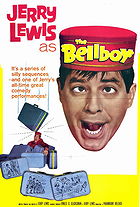 Posted : 13 years, 2 months ago on 19 February 2012 12:07
(A review of The Bellboy)
Posted : 13 years, 2 months ago on 19 February 2012 12:07
(A review of The Bellboy)First of all, I must confess my weakness for Jerry Lewis. As a child I remember having laughed so much in any circumstance attending the films interpreted by him, whether conducted by himself or, preferably, Frank Tashlin (Rock-a-bye Baby; Who's Minding the Store?; The Disorderly Orderly...)
"The Bellboy" is the first film directed by Lewis but there are already the foundation of his peculiar style. Also the character was created earlier. Heir to the mood and gesture of Stan Laurel (perhaps his main reference), devotes his unique tribute making it appear in several sequences of the film and even adopting the artist protagonist, Stanley, same name. Unfortunately, the famous pair of Oliver Hardy was ill during filming and had to be double official who interpreted.
In the narrative, the movie is a constant succession of brief scenes fun, almost kind sketch of different depth and interest, yes, with a preponderance of the visual, as usual in films of Lewis. However, the absurdity, fantasy and even surrealism that will make you famous in his career, and fitting in well in this movie and it is for cheer.
"The Bellboy" is the first film directed by Lewis but there are already the foundation of his peculiar style. Also the character was created earlier. Heir to the mood and gesture of Stan Laurel (perhaps his main reference), devotes his unique tribute making it appear in several sequences of the film and even adopting the artist protagonist, Stanley, same name. Unfortunately, the famous pair of Oliver Hardy was ill during filming and had to be double official who interpreted.
In the narrative, the movie is a constant succession of brief scenes fun, almost kind sketch of different depth and interest, yes, with a preponderance of the visual, as usual in films of Lewis. However, the absurdity, fantasy and even surrealism that will make you famous in his career, and fitting in well in this movie and it is for cheer.
 0 comments, Reply to this entry
0 comments, Reply to this entry
Rififí en la ciudad (1963)
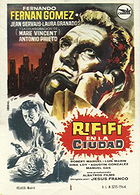 Posted : 13 years, 2 months ago on 18 February 2012 01:50
(A review of Rififí en la ciudad)
Posted : 13 years, 2 months ago on 18 February 2012 01:50
(A review of Rififí en la ciudad)"Rififi in the city" is the first adaptation of a novel in the filmography of prolific Spanish director Jesus Franco. With a cast is not devoid of stars, like great actors Jean Servais and Fernando Fernán-Gomez, the film was shot in a studio outside Madrid and Levantine, obeying the order of Francoist censorship convert the Barcelona of the novel in an imaginary hispanoamerican city.
The movie is commendable attempt to unite his passionate admiration for Orson Welles's cinematography with different drives his own filmmaker. This faithful obedience to Charles Exbrayat French novel it is based, which implies an additional merit. It is a type of "Polar" in Spanish, with absorbing atmosphere, well recreated despite its obvious limitations in their financial budget. Failure as usual in the work of Jesus (Jess) Franco hit a staging style sometimes laughable, implausible as to jump on the script and archetypal situations and characters too or fanciful. In this respect, the role played by Agustín Gonzalez is quite a psychiatric clinical case. To all this, highlight the positive treatment of the different stage of the night club musical numbers, with perfect timing and a heady taste with excellent use of the reverse shot, involving the viewer.
Although minor, one of the movies that entertains and director worth his vision.
The movie is commendable attempt to unite his passionate admiration for Orson Welles's cinematography with different drives his own filmmaker. This faithful obedience to Charles Exbrayat French novel it is based, which implies an additional merit. It is a type of "Polar" in Spanish, with absorbing atmosphere, well recreated despite its obvious limitations in their financial budget. Failure as usual in the work of Jesus (Jess) Franco hit a staging style sometimes laughable, implausible as to jump on the script and archetypal situations and characters too or fanciful. In this respect, the role played by Agustín Gonzalez is quite a psychiatric clinical case. To all this, highlight the positive treatment of the different stage of the night club musical numbers, with perfect timing and a heady taste with excellent use of the reverse shot, involving the viewer.
Although minor, one of the movies that entertains and director worth his vision.
 0 comments, Reply to this entry
0 comments, Reply to this entry
The Chaser (Chugyeogja, 2008)
 Posted : 13 years, 2 months ago on 16 February 2012 05:39
(A review of The Chaser)
Posted : 13 years, 2 months ago on 16 February 2012 05:39
(A review of The Chaser)"The Chaser" reminded me almost from the start to another great thriller "I Saw The Devil", but neither is far from "Memories of Murder" or many korean titles in recent years. It seems the last korean cinematography based much of his success in these thrilling stories with serial murderer police involved. Another hallmark of these films is their almost morbid delectation in extreme violence, although in "The Chaser" is well dosed, is not as overwhelming as in "I Saw the Devil", for instance.
But the main thing, what really matters is the solid, well-structured script, the plot quickly and perfectly developed, with some surprising plot twists that always surprise the viewer and make the vision of the film does not decrease its interest at any time. Add to it a credible and well-shaped characters and above all an excellent film direction, which leaves no aspect to chance, and knows wisely dosed tension, black humor and emotional impact. Until the soundtrack comes only at the most relevant, opting for silence in the sequences of greatest tension, leaving the astonished observer face to face with the starkest of horrors, as a participant in the same subject.
Impossible to avoid this uncontrolled flood but, in turn, modulated voltage as well. It is only fair to admit, the best film noir lies in South Korea and seems set for a long time.
But the main thing, what really matters is the solid, well-structured script, the plot quickly and perfectly developed, with some surprising plot twists that always surprise the viewer and make the vision of the film does not decrease its interest at any time. Add to it a credible and well-shaped characters and above all an excellent film direction, which leaves no aspect to chance, and knows wisely dosed tension, black humor and emotional impact. Until the soundtrack comes only at the most relevant, opting for silence in the sequences of greatest tension, leaving the astonished observer face to face with the starkest of horrors, as a participant in the same subject.
Impossible to avoid this uncontrolled flood but, in turn, modulated voltage as well. It is only fair to admit, the best film noir lies in South Korea and seems set for a long time.
 0 comments, Reply to this entry
0 comments, Reply to this entry
 Login
Login
 Home
Home 187 Lists
187 Lists 208 Reviews
208 Reviews Collections
Collections